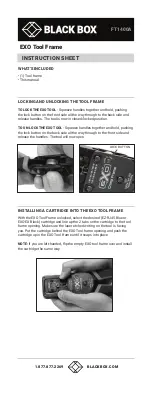
4
For technical questions call 1-800-665-8685
V 3.05
8474116
20 Gallon Pressure Abrasive Blaster
3. Do not allow people, mobile equipment or vehicles to pass over the unprotected air line. Position the
airline away from high traffic areas, in a reinforced conduit or place planks on both sides of the airline to
create a protective trench.
4. Prevent damage to the air line by observing the following:
a. Never carry the tool by the air line.
b. Keep the air line behind the tool and out of the tool’s work path.
c. Keep the air line away from heat, oil, sharp edges or moving parts.
d. Do not wrap the air line around the tool as sharp edges may pierce or crack the airline. Coil the airline
when storing.
5. A damaged or disconnected air line under pressure may whip around and inflict personal injury or damage
the work area. Secure the compressor’s air line to a fixed or permanent structure with clamps or cable ties.
6. Install an in-line shutoff valve or regulator to allow immediate control over the air supply in an emergency,
even if a hose is ruptured.
VIBRATION PRECAUTIONS
This tool vibrates during use. Repeated or long-term exposure to vibration may cause temporary or permanent
physical injury, particularly to the hands, arms and shoulders.
1. Anyone using vibrating tools regularly or for an extended period should first be examined by a doctor and
then have regular medical check-ups to ensure medical problems are not being caused by or worsened
from tool use. Pregnant women or people who have impaired blood circulation to the hands, past hand
injuries, nervous system disorders, diabetes or Raynaud’s Disease should not use this tool. If you feel
any medical symptoms related to vibrations (such as tingling, numbness, and white or blue fingers), seek
medical attention as soon as possible.
2. Do not smoke during use. Nicotine reduces the blood flow to the hands and fingers, increasing the risk of
vibration-related injury.
3. Wear suitable gloves to reduce the vibration effects on the user.
4. Use tools with the lowest amount of vibration when there is a choice between different processes.
5. Do not use for extended periods. Take frequent breaks when using this tool.
6. Let the tool do the work. Grip the tool as lightly as possible (while still keeping safe control of it).
7. To reduce vibrations, maintain the tool as explained in this manual. If abnormal vibrations occur, stop
using this tool immediately.
TOOL USE AND CARE
WARNING! Do not use the tool if the trigger or ON / OFF switch does not function properly. Any tool that cannot
be controlled with the ON / OFF switch is dangerous and must be repaired.
1. Use the correct tool for the job. Maximize tool performance and safety by using the tool for its
intended task.
2. Do not modify this tool or use for a purpose for which it was not designed.
3. This tool / device was designed for a specific function.
Do Not:
a. Modify or alter the tool; all parts and accessories are designed with built-it safety features that may be
compromised if altered.
b. Use the tool in a way for which it was not designed.
4. Avoid unintentional starts. Be sure the trigger is in the neutral position when not in use and before
connecting it to any air source.
5. Maintain the tool with care (see Maintenance).





































